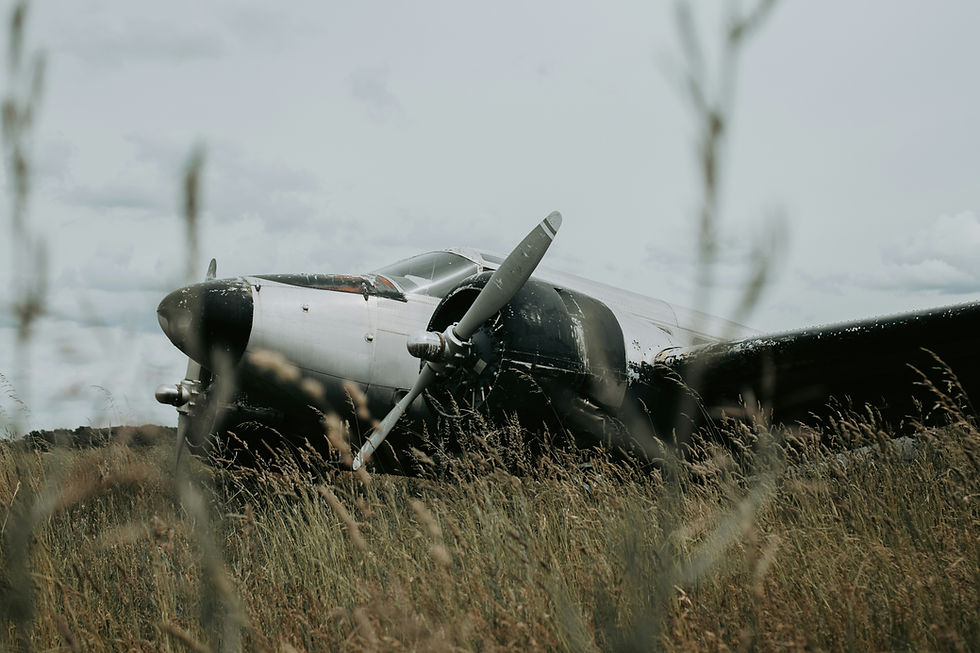Losing Pressure
- David Smith

- Nov 5, 2022
- 4 min read
Updated: May 10, 2024
October 5, 2022
Words by David Smith (CEO)
This story happened a few years ago.

PA-28 Piper Arrow
It was the day before Thanksgiving, I was getting ready for a flight to Camarillo, California that morning from the Riverside airport (KRAL), in Riverside, CA. It was a very nice warm clear sunny day, like it normally is in Southern California. There was no wind; the temperature was at the time about 60 degrees and warming up. I completed the pre-flight like I always do every time before I fly, per the pre-flight checklist and more. I always go beyond what the checklist says, which there is nothing wrong with doing, to look at more items or areas on the airplane. When I checked the oil level on the deep stick, the oil level showed 5 quarts. On this particular airplane, a PA-28 Piper Arrow, the max oil level for the engine oil system is 6 quarts, and the lowest oil level is 3 quarts. A Piper Arrow is a low wing airplane with a retractable landing gear system and a constant speed propeller.
I got situated in the airplane and started up, contacted the ground control (ATC) at Riverside for a taxi clearance. Taxied out to the departing runway being used for the day, normally its runway 27. Completed the run-up as normal via the checklist. No issues were noted. Rolled out on to the runway, gave it full throttle and raced down the runway, climbed out, with a continuing climbing left turn heading south. While on a south bound climb, Riverside Tower had me switch radio frequencies and contact Southern California (SoCal) Approach for flight following to Camarillo, as per my request with the ground controller, before taking off. A few minutes later, SoCal Approach told me to resume own navigation; basically, fly any route I wanted. Direct or via a VHF omnidirectional Range (VOR) station, all under visual flight rules (VFR) conditions, basically just looking out of the front wind screen. A VOR station is used for navigation by aircraft. It's a short-range radio navigation system.

I then made a right turn to fly direct to the Pomona VORTAC, then continuing on direct to Camarillo. That is the easiest route to fly to avoid flying through the busy Class Bravo airspace for LAX (Los Angeles International).
As I was approaching the Pomona VORTAC, I began to level off the airplane at my assigned cruising altitude of 4,500 feet MSL (measured sea level). The sky was clear as could be, well, by Southern California standards. The winds were so calm that the airplane could fly itself like flying on glass, almost like Mother Nature’s autopilot, in perfect VFR conditions.

After I had crossed the Pomona VOR and began making my left turn to fly westbound, towards Burbank, over Universal Studios and Warner Brothers studios and on to Camarillo airport. I had looked down to do a quick check of all the engine indications and noticed that the oil pressure gauge needle was in the yellow arc near the red line (not a good sign). I then looked at the oil temperature gauge and saw it was reading a hotter temperature than normal.
I immediately contacted SoCal Approach and told them I was cancelling my flight to the Camarillo airport and needed to return to Riverside airport. SoCal, then cleared me back to Riverside and asked what the issue was. I had informed them, "I have low oil pressure indicated, with no other issues at this time." SoCal approach then asked me, "Are you declaring an emergency at this time?" My response was, "not at his time." At the time it was not an emergency issue. Approach then said if you need to land at any other airport close to my current location, that I was cleared to do so. My options were Brackett Field being the closest, Ontario International or Chino Airport. As I continued flying my way back to Riverside, I was monitoring the oil pressure and temperature gauges. I had also increased the fuel mixture to full rich, to help cool the engine down.

A good pilot is always thinking ahead of the airplane and situations, so I began to get myself setup for the possibility of the engine quieting and seizing, which then would become an emergency landing. Pulled out the checklist and began reviewing it and looking out the windows for a possible safe place to land if I needed to, if I was unable to make it to a nearby airport.
I was able to make it back to the Riverside Airport safely and landed with no further issues.
Later that day, the aircraft mechanics had arrived at the airport, to look at the airplane. Their findings were they had found a small pin hole in one of the oil lines. During flight, so much oil had shot out through the pin hole that the oil level was down to one quart left in the engine oil system. The location of the oil line and the pin hole was in a place where, during the pre-flight walk around and inspection of the engine area, no one or any pilot would have seen the pin hole in the oil line.





Comments